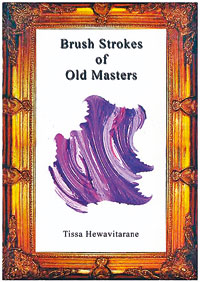A wide and varied canvas
From astounding temple murals to elegant portraits of the affluent women of Colombo 7, ‘Brush Strokes of Old Masters’ features 26 artists who pioneered and influenced the contemporary art scene in Sri Lanka.
 Written by well-known water colourist Tissa Hewavitarane, the book highlights the golden age of artists in Sri Lanka. The genesis of the 43 Group resulted in international recognition of Sri Lankan artists. The author believes that these artists were “pioneers who played a significant role in the development of arts in Sri Lanka.” Hewavitarane began his career in 1958 as an advertising artist at J. Walter-Thompson Far-East. After experimenting with various mediums, he chose watercolour painting as his main medium. In addition to his artistic talents, Hewavitarane was also an eloquent writer. He was invited to write a series on the old masters by former Associate Editor of the Sunday Observer, Kalabushana R. S. Karunaratna. The series was well received by its readers.
Written by well-known water colourist Tissa Hewavitarane, the book highlights the golden age of artists in Sri Lanka. The genesis of the 43 Group resulted in international recognition of Sri Lankan artists. The author believes that these artists were “pioneers who played a significant role in the development of arts in Sri Lanka.” Hewavitarane began his career in 1958 as an advertising artist at J. Walter-Thompson Far-East. After experimenting with various mediums, he chose watercolour painting as his main medium. In addition to his artistic talents, Hewavitarane was also an eloquent writer. He was invited to write a series on the old masters by former Associate Editor of the Sunday Observer, Kalabushana R. S. Karunaratna. The series was well received by its readers.
Upon numerous requests from readers he felt compelled to put this book together. The ‘Old Masters’ were not simply painters; they were sculptors, dancers, poets and musicians. He carefully handpicked 26 of Sri Lanka’s best artists, many of whom have left this earth – their legacies left behind in the form of art. They were pioneers, who were not afraid to experiment, take risks and explore new themes and techniques. These were the people who shaped contemporary and traditional Sri Lankan art and inspired people both in Sri Lanka as well as globally. Their paintings can be found in well-known exhibits and galleries all around the world.
The book introduces its first artist Saradius Lankatileke, known as one of Sri Lanka’s greatest oil painters. He is followed by Solias Mendis, Tilake Abeysinghe, David Paynter, Ananda Samarakoon, Stanley Kirinde, Harry Pieris, Aubrey Collette, L.T.P. Manjusri, Gate Mudaliyar Amarasekara, M. Sarlis, Susil Premaratne, George Keyt, Ivan Peries, Saraswathi Rockwood, Mudaliyar Tudor Rajapaksa,S. P. Charles along with many other masterful artists. Some were members of the 43 Group.
The 43 Group was formed in 1943 in Colombo as a reaction to the rigid nature of Victorian naturalism and bleak artistic views within the Ceylon Society of Arts. It bears similarities with ‘Salon des Independants’ a French group that was founded in 1884 in Paris as a response to the constricting nature of traditionalism in the art scene.
Saradius Lankatileke was a versatile portrait painter. He attended Ceylon Technical College in 1932, where he learned oriental and occidental art under the lecturer and famous portrait painter J. D. A. Perera. Hewavitarane describes Saradius’ as a man who possessed the “unlimited dreams of a god but the limited power of a man. His ambition was to do all things and to do them flawlessly.” The author shares that Saradius went beyond simply capturing the best features of a person; his brush captured the very essence of their persona. Two of his paintings ‘At the Bazaar’ and ‘Lord Buddha and Two Disciples’ are on display at the Ceylon Society of Arts Gallery as permanent exhibits. He received a plethora of awards and certificates for his work over the span of his career, including the Samaradiwakara Prize.
David Paynter entered the Royal Academy open competition with no formal art lessons and won a five-year scholarship. He won the Royal Academy Gold Medal at the end of the fourth year, along with the Edward Stott Travelling Scholarship. His earlier works were religious. He eloquently portrayed the spiritual relationship between God and mankind. Upon proving his skill in religious pictures, he took an interest in portraiture. Hewavitarane tells his readers that Paynter “gave magnificent expression to the qualities that characterised his sitters.” Paynter painted the mural “The Transfiguration” which is considered to be one of his greatest works in 1968 at S. Thomas’ College Chapel in Mount Lavinia.
Ananda Samarakoon was a versatile artist across many disciplines. He was a painter and a musician. Hewavitarane considers him to be one of Sri Lanka’s most talented painters. His painting techniques although simple, create a striking and elaborate piece. He is well known for his illustrations of the song ‘Ennada Menike Mamath Diyambata.’
“His imagination was all embracing.” His paintings were “unique and very much his own but intermixing the fine points and ingredients of Indian art,” Hewavitarane writes.In 1946, while teaching music and art at Mahinda College in Galle, he composed ‘Namo, Namo Matha.’ It became the official national anthem of Sri Lanka in 1952.
‘Brush Strokes of Old Masters’ takes the reader on a journey of each artist’s life and shares the very things that stirred their souls. The author gives insight to the inspiration behind their work and the great passion with which these artists worked to create their masterpieces that today adorn the walls of galleries and private art collections both here and the world over.
Book facts
Brush Strokes of Old Masters by Tissa Hewavitarane. Reviewed by AnneMarie De Silva


